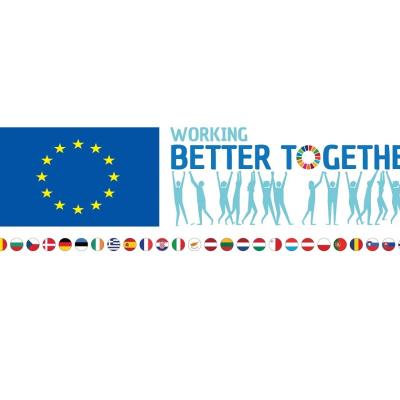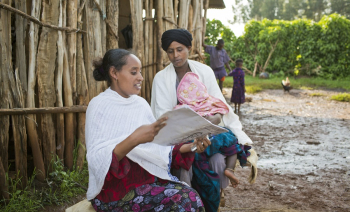Development programmes always strive to be as effective as possible – one way of achieving efficiency is to combine the strengths of all partners working in the sector. A recent evaluation of EU Joint Programming has shown that this policy mechanism offers many advantages.
"Joint Programming is essentially a politically decided programme about how the EU, as a community, will become a better donor community,” said Arne Disch, Managing Partner at Scanteam and team leader for the evaluation on Joint Programming. “It makes the EU closer in its partnership with host countries, as it requires that all actors on the ground be on the same page – you need to have political clearance and active political support from the capitals,” he added.
By making development assistance more effective, Joint Programming also gives the EU greater visibility and leverage, said Ceriani Sebregondi Filiberto, Head of the Development Cooperation Coordination Division at the European External Action Service (EEAS).
“Joint Programming is a way for the EU and Member States to increase overall influence and leverage in their relations with the various countries,” he said.
Another added value is the capacity of EU Member States and partners to act together with a common analysis and vision. “Joint Programming has helped increase the EU’s leverage in policy dialogue with partner countries – ensuring coordinated positions and joint approaches to sectoral challenges,” said Laurent Sarazin, Head of Unit for Development Financing and Effectiveness and Relations with Member States at Directorate-General for International Cooperation and Development (DEVCO).
|
Joint Programming in brief Joint Programming entails shared planning by the EU and its Member States with partner countries, on the basis of national development strategies. This includes a joint analysis of needs and a joint response that sets out how EU development partners provide support and measure progress. Facilitated by the European Commission’s DG DEVCO, DG NEAR and the EEAS, Joint Programmes are developed by EU Delegation and Member State staff based in a partner country, in alignment with the partner country’s national development plan. Joint Programmes set out an overall rationale and vision of the EU and Member States, assigning responsibilities over sectors and areas and outlining the provisional figures for financing. |
A strategic tool for coordination
Since the 1980s, the EU has been calling for greater coordination in development planning. Notably, the 2009 Lisbon Treaty promised more joint working and “whole of Europe” approaches, including on development policy. This led the EU to present its Joint Programming approach to the Fourth High-level Meeting on Aid Effectiveness, held in Busan, South Korea, in November 2011, which launched the UN-led Global Partnership for Effective Development and Cooperation (GPEDC).
The GPEDC partnership has emphasised the principles of country ownership, with a focus on results, inclusive partnerships, transparency and accountability. At the conference, the EU made a commitment to Joint Programming, and followed it up in 2016 with conclusions at the European Council meeting, stating that Joint Programming should be promoted and strengthened, while being kept voluntary, flexible, inclusive, and tailored to the country context.
“The Council conclusions insist on a more strategic view of Joint Programming and joint implementation, enhancing the capacity of Member States to work together and having a more dynamic relationship with the [partner] country,” Filiberto said.
“Since the adoption of these conclusions there has been a lot of movement in our partner countries, and more than 60 delegations have engaged in Joint Programming. Some have it as a complete framing for governing cooperation; for others there is more focus on certain sectors.”
An emphasis on flexibility
The involvement of EU Delegations was also made more effective by the Council’s emphasis on flexibility. “Joint Programming is a menu where you have several options,” Filberto said. “You can focus on one sector or several; on a small group of Member States or on all of them.”
“Some years back”, Filiberto added, “a lot of Member States had the feeling that Joint Programming was a Brussels dictatorship. Now there is more understanding that it’s not a straightjacket but should serve the purpose of being more effective and influential in the country.”
This has reduced a lot of resistance, with the idea of flexibility becoming key for action on the ground. “My experiences in Ghana and Tanzania confirm this,” Filiberto said. “You need to know the added value of every partner and how best to combine them, and not be shocked if one or two Member States are not willing to join.”
Member States can also take the lead on specific sectors, as Italy has done on health and gender in Senegal and Palestine. “Member States have utilised Joint Programming as a strategic policy tool, so it is not just bureaucratic, but adds value from a strategic policy perspective,” said Chiara Venier, Senior Expert on General Affairs and Programming at the Italian Ministry of Foreign Affairs and International Cooperation.
“We should continue to work together with the Commission and strengthen our efforts at country level. At the country level, a devolution of power is needed to obtain results.”
Reinforcing the European aid system
But flexibility must be accompanied by political impetus, said Ana Maria Quevedo Solares, in charge of the relations with the Bilateral European Development Actors at the French Development Agency. “Joint Programming,” she said, “needs to consolidate a European aid architecture that is more than the sum of its parts, drawing on the comparative advantages of multiple partners, including EU institutions, Member States, agencies and development banks.”
The different partners, she added, “represent a rich heritage – and are important with regards to their expertise, financial instruments, geographical coverage, and understanding of national contexts. The European architecture needs to favour a true mutualisation – both of the financing capabilities of its partners, but also with regards to their analytical capacities.”
Quevedo Solares gave the example of the Practitioners Network for European Development Cooperation – a platform which groups 14 Member State development agencies around the Commission in order to further cooperation. The network has engaged in multiple coordination studies, including in fragile states – which, according to Quevedo Solares, fall in line with the evaluation of Joint Programming.
The evaluation, published in April 2017, recommended that the intervention logic for defining its strategic purpose be improved and updated. The evaluation also recommended keeping the strategic, flexible and pragmatic aspects of Joint Programming – along with calling for a clarification and reinforcement of the roles of all stakeholders.
Aligning interests
To work well, Joint Programming must take on board the EU and Member States’ agendas, but, more importantly, it has to be aligned with the interests of the partner government.
Cambodia, for example, was initially not interested in Joint Programming, Disch recalled, simply because the government could not see any advantages to it. Over time, however, as the dialogue evolved, the government became convinced that the process could provide them with gain – they then began structuring the dialogue and programme around their own priorities as the dialogue progressed.
In Mozambique, on the other hand, Joint Programming focused on a few key sectors rather than addressing the complete aid picture. “One reason was that the long-standing Donor Budget-Support Working Group had become a time-consuming exercise the country wanted to scale back on,” said Disch.
|
What are the benefits of Joint Programming – and does it work? Find out here: |
The EU and the government worked together to identify broad thematic areas – good governance and development, and rural development – where coordination would be more beneficial. Joint Programming with the EU Member States was accordingly structured to focus on these.
With existing mechanisms and experiences to build on, the dialogue allowed for the identification of sectors where Joint Programming could have the biggest value given the country priorities. “As with any coordination process, Joint Programming is quite demanding of all parties around the table – so being flexible and jointly finding the best use for resources is key,” said Disch.
Expanding on a successful modality
This flexibility is all the more useful with the increased coherence the modality brings. “Countries know that when the EU Delegation talks to them, the EU and Member States all agree on what’s being put on the table. This gives more weight to what is being said,” said Sarazin.
Recently, the Commission and the EEAS have updated and revised the Joint Programming Guidance. They are also analysing how Joint Programming can better help fragile countries and those that transition to higher income levels, in addition to reviewing all available joint results frameworks that can currently be found in Joint Programmes.
“Joint Programming is by essence a dialogue between the donors and the government,” Sarazin said. “It can only effectively take place in the country, and its success depends on the commitment of all the stakeholders. In Brussels, we can provide support, methodologies and guidance, but things can only happen on the ground.”
This article was written by Sebastian Moffett, with input from the Capacity4dev Team and Unit A2 at DG DEVCO.




Log in with your EU Login account to post or comment on the platform.